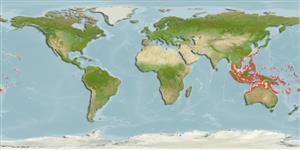>
Ovalentaria/misc (Various families in series Ovalentaria) >
Pomacentridae (Damselfishes) > Pomacentrinae
Etymology: Amphiprion: Greek, amphi = on both sides + Greek, prion, -onos = saw (Ref. 45335).
More on author: Bleeker.
Environment: milieu / climate zone / depth range / distribution range
Sinh thái học
Biển; Thuộc về nước lợ Cùng sống ở rạn san hô; không di cư; Mức độ sâu 1 - 38 m (Ref. 86942). Tropical; 34°N - 22°S, 96°E - 156°E (Ref. 55269)
Western Pacific: Gulf of Thailand and Cocos-Keeling in the eastern Indian Ocean to Samoa and Tonga (Ref. 53797), north to the Ryukyu Islands, south to the Great Barrier Reef, and New Caledonia.
Length at first maturity / Bộ gần gũi / Khối lượng (Trọng lượng) / Age
Maturity: Lm ?, range 6 - ? cm
Max length : 10.0 cm TL con đực/không giới tính; (Ref. 9710)
Các tia vây lưng cứng (tổng cộng) : 9 - 10; Các vây lưng mềm (tổng cộng) : 16 - 17; Tia cứng vây hậu môn: 2; Tia mềm vây hậu môn: 12 - 13.
Adults inhabit lagoon and seaward reefs (Ref. 1602). Mainly diurnal. Non-burrowing. Monogamous (Ref. 52884). A protandrous hermaphrodite (Ref. 32166). Oviparous, distinct pairing during breeding (Ref. 205). Eggs are demersal and adhere to the substrate (Ref. 205). Males guard and aerate the eggs (Ref. 205). Associated with the anemones: Heteractis magnifica (usually), Heteractis crispa, Macrodactyla doreensis, Stichodactyla gigantea (Ref. 5911). In Bali they occur together with the closely related Indian Ocean species A. akallopison and have even been found sharing the same anemone (Ref. 48636). Has been reared in captivity (Ref. 35413, 35418, 35420).
Oviparous, distinct pairing during breeding (Ref. 205). Monogamous mating is observed as both obligate and social (Ref. 52884). Eggs are demersal and adhere to the substrate (Ref. 205). Males guard and aerate the eggs (Ref. 205). One pair spawns several times per year. Annual fecundity is estimated to be 2,000 to 4,000 eggs. Size at sex change = 5.4 cm TL (Ref. 55367). Also Ref. 240, 7471.
Allen, G.R., 1991. Damselfishes of the world. Mergus Publishers, Melle, Germany. 271 p. (Ref. 7247)
IUCN Red List Status (Ref. 130435: Version 2024-2)
Threat to humans
Harmless
Human uses
Các nghề cá: không ích lợi (thú vị); Bể nuôi cá: Tính thương mại
Các công cụ
Special reports
Download XML
Các nguồn internet
Estimates based on models
Preferred temperature (Ref.
123201): 25.2 - 29, mean 28 °C (based on 668 cells).
Phylogenetic diversity index (Ref.
82804): PD
50 = 0.5000 [Uniqueness, from 0.5 = low to 2.0 = high].
Bayesian length-weight: a=0.02344 (0.01134 - 0.04848), b=2.98 (2.80 - 3.16), in cm total length, based on LWR estimates for this (Sub)family-body shape (Ref.
93245).
Mức dinh dưỡng (Ref.
69278): 2.2 ±0.0 se; based on diet studies.
Generation time: 2.3 ( na - na) years. Estimated as median ln(3)/K based on 1
growth studies.
Thích nghi nhanh (Ref.
120179): Trung bình, thời gian nhân đôi của chủng quần tối thiểu là 1.4 - 4.4 năm (K=0.48; tm=1.75-1.83; annual Fec=2,000-4,000).
Fishing Vulnerability (Ref.
59153): Low to moderate vulnerability (26 of 100).
Nutrients (Ref.
124155): Calcium = 111 [49, 178] mg/100g; Iron = 0.729 [0.430, 1.319] mg/100g; Protein = 18.1 [16.9, 19.3] %; Omega3 = 0.121 [0.068, 0.207] g/100g; Selenium = 23.3 [11.3, 48.4] μg/100g; VitaminA = 94.4 [22.7, 361.4] μg/100g; Zinc = 2.33 [1.52, 3.68] mg/100g (wet weight);
